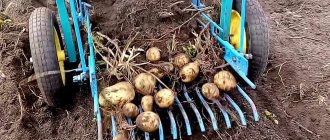Description of the variety
| Variety name | Belmond |
| general characteristics | mid-early table variety, one of the most promising European varieties |
| Maturation period | 70-80 days |
| Starch content | 14-16% |
| Weight of marketable tubers | 100-125 gr |
| Number of tubers in a bush | 12-16 pcs |
| Productivity | 450-800 c/ha |
| Consumer qualities | excellent taste, low overcooking |
| Keeping quality | 97% |
| Peel color | yellow |
| Flesh color | yellow |
| Preferred Growing Regions | any soil and climate |
| Disease resistance | highly resistant to rhizoctonia, black mold, late blight of tops and tubers, rust and black spots |
| Features of cultivation | standard agricultural technology |
| Originator | German Seed Alliance Solagro |
Belmondo potatoes are considered a mid-early variety; the period from the appearance of most shoots to technical maturity ranges from 70 to 80 days. Like most varieties of potatoes, “Belmondo” has conditional ripeness, which occurs a little earlier than technical ripeness.
Read about how to grow early potato varieties here.
Reference. Technical maturity - potatoes have reached optimal size and have thick, durable skin. Conditional maturity - potatoes are of normal size, the skin is thin, fragile, lagging. However, flaky peel indicates that the tubers are unripe.
“Belmondo,” according to the inspection commission, has a rounded oval shape, average dimensions—about 9 cm in diameter, weight—about 120 grams. The peel is yellow, strong, smooth, the eyes are small, shallow (superficial).
You can compare the tuber weight and starch content of Belmondo potatoes with other varieties using the table below:
| Variety name | Starch content (%) | Mass of tubers (g) |
| Belmondo | 14-16 | 100-125 |
| Artemis | 11-15 | 110-120 |
| Tuscany | 12-14 | 90-125 |
| Openwork | 14-16 | 95-115 |
| Santana | 13-17 | 100-170 |
| Nevsky | 10-12 | 90-130 |
| Ramos | 13-16 | 100-150 |
| Lapot | 13-16 | 100-160 |
The presence of shallow eyes in potatoes greatly facilitates packaging, washing, peeling and other processing.
"Belmondo" is distinguished by its bright yellow flesh. The starch content in this variety is about 16%, which is average. Potatoes do not overcook because they have a low level of starch. Shoots of the Belmondo potato variety have the following distinctive characteristics:
- The stem bush is tall and spreading.
- The leaves are located intermediately, typical of potatoes in shape, dark green in color, wrinkled in structure, no pubescence, weak wavy edges.
- Flowers usually have a dark red or light purple corolla.
Landing
Belmondo potatoes (the description of the variety and photos are provided for reference) can be planted in the ground no earlier than the soil warms up to a temperature of +12 °C at a depth of 12-18 cm. You can check this indicator with a regular thermometer by sticking it into the soil. As a rule, suitable conditions in the central and northern regions are formed by the first ten days of May. In the south, you can start planting from mid-April.
It is better to plant potatoes in parallel furrows. This simplifies both planting and caring for the plant. Before the event, it is advisable to prepare the site by making the soil looser and more fertile. But if you don’t have time for this, you can add fertilizer directly to the holes.
Preparation of planting material
To get a good harvest of vegetables, it is important to prepare the seed tubers for planting.
This should be done 2-3 weeks before the event, following these instructions:
- Transfer the tubers to a bright place with a temperature of +16...22 °C. Sort the potatoes, remove all damaged and rotten specimens.
- Spread healthy planting material in one layer on a flat surface.
- Sprinkle the tubers with water daily. This way your eyes will wake up faster. It is also advisable to turn the potatoes daily so that each side is illuminated with light.
- After 10 days, it is advisable to reduce the temperature to +15 °C. Otherwise, the sprouts may outgrow.
1-2 days before planting, treat each potato with a solution of insectofungicides Prestige or Clubbershielt, being careful not to damage the sprouted eyes. You can also soak the tubers in growth stimulants (Epin, Zircon), which will speed up their establishment in a new place.
Selection and preparation of a landing site
Belmondo potatoes (the description of the variety and photos confirm its productivity) should be planted in open, sunny areas. Lowlands and places with close groundwater are not suitable for it. The plant takes root in any type of soil, but fertile sandy loam or loam is ideal for it.
When choosing a site, it is important to remember the rules of crop rotation. So, potatoes cannot be planted in one place for 2 years in a row, or grown after other Solanaceae (tomatoes, peppers, eggplants). The best predecessors for the crop will be legumes, cabbage, carrots, onions, and cucumbers.
If it is not possible to change the location for potatoes every year, then immediately after harvesting you need to sow green manure or winter grain crops (rapeseed, mustard, oats) on the site. Before frost, they will grow a lush green mass, which should be mowed at the end of autumn, but not removed, but left to lie until spring. This technique will significantly improve the soil structure, saturate it with organic matter, nitrogen and other necessary substances.
In early spring, it is necessary to prepare the area for potatoes, following the following instructions:
- Dig the soil to a depth of 35-40 cm. In the process, remove all plant debris, weed roots and debris.
- Add to each sq. m 5-7 kg of humus or compost. You should absolutely not use fresh manure, as it can burn the roots of the plant. You can replace organic matter with wheel fertilizers (superphosphate, nitrophoska, special preparations for potatoes).
- Heavy clay soil should be loosened with sand or rotten sawdust (500 g per 1 sq. m). Sandy soil needs to be diluted with peat.
The site preparation should be completed 3-4 weeks before planting the potatoes.
Landing rules
Planting potatoes is a simple procedure that even a novice gardener can handle.
It consists of the following stages:
- Dig holes with a depth of 5-10 cm. Maintain a distance of 30 cm between them. The row spacing should reach 70 cm. The rows should be placed in the direction from north to south so that all the bushes do not shade each other.
- Pour 0.5-1 liters of water into each well.
- Place the sprouted potatoes in the holes, sprouts facing up.
- Rub the tubers with wood ash and cover them with soil. If there is a risk of return frosts, the bed should be covered with agrofibre.
If you did not have time to prepare the area for potatoes in advance, you can apply fertilizer directly to the holes during planting. 200 g of humus should be added to each of them. As for mineral fertilizers, it is better to use nitroammophoska (3-4 g). You will need to thoroughly mix the fertilizer with the soil, and only then lay the potatoes on it. Otherwise, the tubers will get burned and die.
Productivity
"Belmondo" brings an excellent harvest, about 80 tons per 1 hectare, deviations are smaller or larger depending on the regions. The variety has tubers that are almost equal in size and a small proportion of small and large root crops. Many tubers develop from one plant.
In the table below you can see what the yield is and how many tubers there are in a bush for other potato varieties:
| Variety name | Productivity (c/ha) | Number of tubers in a bush (pcs) |
| Belmondo | 450-800 | 7-9 |
| Gourmet | 350-400 | 12-14 |
| Palm | up to 450 | 5-9 |
| Blue Danube | 350-400 | 8-12 |
| Lily | up to 670 | 8-15 |
| Tiras | 210-460 | 9-12 |
| Colombo | 220-420 | up to 12 |
| Santa | up to 570 | up to 20 |
Potato care
Potatoes of the Belmondo variety, photos of which clearly demonstrate the size of its tubers, are unpretentious crops. But according to his description, in order to get the maximum yield, it is important to provide the plant with proper care, which consists of normal agrotechnical measures.
Watering and fertilizing
Belmondo potato varieties are not drought-resistant; they require regular but moderate watering. The first irrigation should be carried out when the plants reach a height of 10-12 cm. You will need to pour 5-6 liters of water under each bush.
During flowering, it is advisable to repeat the event every 3-4 days. In the future, it is enough to water the planting 3 times a month. But if the weather is hot and dry, then you should irrigate the garden bed every 5-6 days. It is better to water potatoes in the evening, after sunset. Otherwise, the moisture will quickly evaporate under the sun, and the leaves will get burned. 10-12 days before planting, watering should be completely canceled.
To increase the yield, it is advisable to feed Belmondo potato varieties according to the following scheme:
- When the plants reach 13-15 cm in height, apply nitrogen fertilizers. It is better to use a liquid solution of ammonium nitrate (10 g per 10 l). For every sq. m of planting, 4-5 liters of fertilizer is enough.
- 10-14 days before flowering, add liquid compositions based on humic acids. Special preparations such as Fusco potato, Kemira for potatoes, and Energen Aqua are suitable. Dilute such fertilizers according to the instructions, and spray the above-ground parts of the plants with the resulting solutions.
- After flowering is completed, add a solution of fermented chicken manure (1:12) under the potatoes. After 7-10 days, repeat feeding. But this time dilute chicken manure in water in a ratio of 1 to 24.
Fertilizers should be applied in the evening, after sunset. Before the event, you need to water the plants well, otherwise they will get burned from fertilizing.
Loosening and weeding
After watering and rainfall, a dense crust forms on the soil surface. It impairs air access to the roots, which interferes with the formation of tubers. To improve soil aeration, it is important to loosen it regularly. But directly near the bushes this must be done carefully so as not to damage the stems and lateral roots of the crop.
Weeds not only take nutrients from the soil, but also transmit pests and pathogens. The potato bed needs to be weeded regularly. The first time the procedure should be carried out when the plants reach a height of 4 cm. In the future, weeding should be combined with loosening.
Hilling
Hilling is an important agrotechnical technique when growing potatoes. Thanks to this event, the growth of lateral roots is activated, which contributes to the growth of tubers and improves their taste.
It is necessary to hill up the crop bushes several times a season:
- When the tops reach a height of 12-15 cm, you need to sprinkle the stem with a mound of earth 3-4 cm thick.
- If the height of the stems is 20-22 cm, you will need to hill them up to 2/3 of the length of the bush.
- Repeat the event after 2 weeks. Increase the hill of earth by another 5-6 cm.
Hilling up should be combined with weeding and loosening. But it is better to carry out the procedure in the evening, especially in the hot season. Otherwise, the stems and young tubers may get burned from the hot earth.
Application
"Belmondo" is a table variety. Intended for consumption.
Potatoes contain a lot of useful substances (vitamin C, B, potassium, phosphorus, protein, etc.), which are used for cosmetic and medical purposes - against edema, tumors, and some prevention of high blood pressure.
Yellow potatoes contain a large amount of carotene, an antioxidant substance that performs a cleansing function in the body.
It is not recommended to eat green or sprouted, soft root vegetables; they contain many times more of the toxic substance - salonin - than healthy, strong tubers; discard such tubers or cut off the peel as thick as possible.
Taste qualities
"Belmondo", judging by the reviews, has excellent taste. Yellow potato varieties are considered the most delicious. The good taste of new potatoes is noted, and there are a lot of recipes for preparing them. These potatoes do not boil soggy, they are great for making salads and soups, but they are not very suitable for making mashed potatoes. Suitable for frying and boiling whole. French fries turn out well .
The most useful way to consume it is to bake it in the oven or in coals in the skin; boiling it “in its jacket” also preserves many vitamins.
Advice from experienced gardeners
Experienced gardeners believe that if in wet weather the tops on potato bushes do not dry out but continue to turn green, then they must be mowed 7-10 days before harvest.
Don’t put off harvesting potatoes from the garden. This has a bad effect on its keeping quality.
Another piece of advice from experienced gardeners is not to plant potatoes near tomatoes and apple trees. They have common pests.
Important ! To increase productivity, it is necessary to select potatoes for planting from healthy bushes in which the tubers were large in size. Small seeding material will not give a high quality harvest.
Reviews about the Belmondo variety are mostly positive. These potatoes are grown in different regions and produce good harvests everywhere.
Nadezhda, Vladimir region: “Belmondo potatoes have excellent taste. This is one of the most delicious yellow varieties. When cooking, the tubers do not become soft. They are great for soups and salads, although they are not very suitable for making purees. Delicious fried."
Zoya, Perm: “The Belmondo potato variety adapts to different climates, showing high yields and maintaining excellent taste. It is considered one of the most promising European varieties. Belmondo is characterized by tubers that are uniform in size. It has a good presentation."
Advantages and disadvantages
Flaws:
- Low resistance to virus Y.
- Average resistance to leaf curl.
- Sensitive to precipitation and drought.
- A certain type of soil is required.
Advantages:
- high productivity;
- rapid development of tubers;
- evenness in size;
- high taste qualities;
- does not boil over;
- does not darken during cooking;
- high percentage of resistance to most diseases.
Diseases and pests, how to fight
The Belmondo variety is resistant to many fungal diseases - late blight, mold, and various rots. However, it is susceptible to attacks by the Colorado potato beetle. To avoid this, preventive treatment with specific drugs will be required: Commander, Taboo, Regent.
Potatoes must be treated against aphids, which carry the Y virus, which is dangerous for the Belmondo variety.
You can prevent contracting diseases by taking the following measures:
- remove infected bushes;
- follow the rules of crop rotation;
- disinfect storage containers;
- Do not plant potatoes next to other plants of the nightshade family.
The characteristics of Belmondo potatoes and reviews about them are interesting to many people. The variety is new, but already popular; with proper care, it can produce a good harvest even in areas with a cold climate. The plant adapts quite easily to new conditions, and if all planting and growing rules are followed, it produces an excellent harvest.
Features of cultivation and storage
It is necessary to prepare the correct soil for potatoes. In the fall, it is necessary to dig up, remove excess weed roots, apply fertilizers containing potassium and phosphorus, nitrogen fertilizing is carried out already when there are plants in the soil, and pesticides are also needed.
Read about what to feed potatoes, when and how to apply fertilizers, and how to do it correctly when planting in the articles on our website.
In the spring, the area should only be dug up. "Belmondo" likes to go deep, so the soil needs to be loosened as deep as possible. Planting begins in April and ends at the end of May. Potatoes should not be planted at very low or high temperatures.
It is good to use calcium nitrate to form strong tubers that can be stored for a long time; it should be used at the root . "Belmondo" produces many root crops, so the distance between plants should be more than 20 cm.
Early and mid-early varieties should not be kept in the ground, so “Belmondo” must be removed on time. Further, growing the variety is no different from other main varieties - weeding, hilling, loosening, fertilizing, watering, mulching.
Read about how to grow potatoes without hilling and weeding here.
"Belmondo" does not germinate when the sprouts are removed once. It must be stored at a constant temperature - from 1 to 4 degrees above zero . The room should be dark and dry.
For information on how to properly store potatoes in winter, on the balcony, in boxes, in the refrigerator and peeled, read in additional materials. And also about the timing, temperature and problems that arise during storage.
How to properly care for the variety
The Belmondo variety is unpretentious. However, proper and regular care increases the possibility of getting a good harvest.
Features of watering
Watering is carried out depending on the growth of the plant and the weather. The first irrigation is carried out when the bushes reach a height of 10-15 cm. After this, the crop is watered weekly, each plant will require up to 5 liters of water.
When buds and flowers appear on the bush, the number of waterings is increased to a couple of times a week, the volume of liquid reaches 10 liters.
Important! With constant rain and cold weather, the amount of irrigation is reduced.
Feeding and fertilizing
Fertilizing the soil begins before planting, during its preparation in the fall, then in the spring. The bushes are fertilized during the formation of buds and flowers. For this purpose, ammonium nitrate, Nitrophoska, and chlorine-free products are used.











